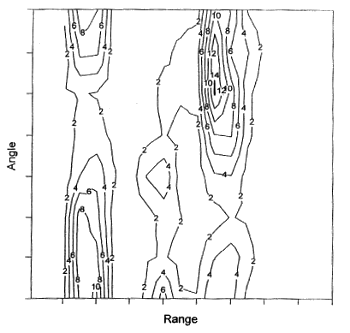Phased Array Detectors
October 21, 2011
The following joke was old even when I was a child, and it's been retold every generation since:
"Have you heard about the guy who invented a device to see through walls?
He calls it a window!"
We were so easily amused in the days before the Internet. More about seeing through walls, but without windows, later in this article.
Waves are characterized by both
amplitude and
phase. The canonical formula for a
sine wave as a
function of time
t is
y(t) = A0sin(ωt + φ),
in which A
0 is the amplitude, ω is the
angular frequency, and φ is the phase. The phase of a wave in isolation isn't important, but phase is important when waves are allowed to mix and
interfere with each other. Of course, there's the example of
Young's double slit experiment that demonstrates the
wave nature of light, but practical applications of phase interference abound.
Sound, just like light, is a wave, so interference effects based on phase difference also occur. I used this principle to good advantage several years ago in a
phased-array acoustic radar for detecting passenger occupancy in
automobiles.[1-2] Passenger occupancy sensing in vehicles is important to prevent unnecessary deployment of
air bags and for detection of
child carriers seats.
In my simple phased array system, acoustic transducers, driven in controlled phase difference to each other, generate a beam of sound energy that scans a region of space. As shown in the
contour plot below, such a system could detect the location and range of objects.

Fig. 13 of US Patent No. 6,549,487, "Steered beam ultrasonic sensor for object location and classification," by Devlin M. Gualtieri (April 15, 2003).[2]
(Via Google Patents))
My acoustic radar couldn't see through walls, but that's the task that a group of researchers at
MIT's Lincoln Laboratory decided to tackle using a similar phased array approach at
microwave frequencies.[3-6] This task involves not only the problem of getting a radar signal through a wall, but also detecting the weak reflected signal as it passes through the wall again back to the observer. A round trip reflection has just 0.0025 % of the original signal strength (-46
dB).
Their system operates similarly to a
scanning confocal microscope. There are thirteen microwave transmitting
antennas that produce a phased array beam that can scan a forward region of space; and there are also eight receiving antennas for acquisition of the reflected signals.[3] The radar system stands about five feet off the ground, and it measures 8.5 feet wide by 2 feet tall.[5] The system has been tested on solid
concrete walls that are four-eight inches thick.
The
frequency chosen for the radar,
S-Band, is the same frequency band used by microwave ovens. S-Band was likely chosen for this application, since the band includes frequencies in the range 2.4-2.483 GHz that are designated for
unlicensed industrial-scientific-medical (
ISM) devices. The system has been successfully demonstrated at ranges from 20-60 feet, and the data are captured at a
video rate of 10.8
frames per second. Some sample images appear below, and a
video demonstration is available on YouTube.[6]

Example images of the wall-penetrating radar system. (a) Two humans in free space (b) Two humans behind a four-inch solid concrete wall (c) Two humans behind a cinder-block wall (d) Two humans behind an eight-inch solid concrete wall. (Via Project Web Site))
In order to increase signal contrast, the system uses a subtractive technique that looks at just the changes from one video frame to another. This allows detection of moving targets (e.g., humans) while rejecting stationary objects such as furniture. Humans, even while sitting still or holding their breath while standing, will show some movement. The radar system was able to detect these small movements.[3,5]
Although the wall-penetrating radar was developed for
military purposes, it would be useful for
emergency response teams searching, for example, for
earthquake survivors.[3]. The authors won the
best paper award for a description of this work at the 2010
Tri-Services Radar Symposium.[3]
References:
- Devlin M. Gualtieri, "Steered beam ultrasonic sensor for object location and classification," US Patent No. 6,327,221, December 4, 2001.
- Devlin M. Gualtieri, "Steered beam ultrasonic sensor for object location and classification," US Patent No. 6,549,487, April 15, 2003.
- Emily Finn, "Seeing through walls," MIT Press Release, October 18, 2011.
- T.S. Ralston, G.L. Charvat and J.E. Peabody, "Real-time Through-wall Imaging Using an Ultrawideband Multiple-Input Multiple Output (MIMO) Phased Array Radar System," Proceedings of IEEE International Symposium on Phased Array Systems and Technology, October 12-15, 2010, pp. 551–558.
- Seeing Through Walls, MIT-Lincoln Laboratory News, June 2011.
- Melanie Gonick, "Seeing through walls - MIT's Lincoln Laboratory," YouTube Video, October 17, 2011.
- Gregory L. Charvat Projects Page.
Permanent Link to this article
Linked Keywords: Amplitude; phase; sine wave; function; angular frequency; interference; Young's double slit experiment; wave nature of light; sound; phased-array; sonar; acoustic radar; automobile; air bag; child carriers seat; contour plot; Google Patents; MIT; Lincoln Laboratory; microwave frequency; decibel; dB; scanning confocal microscope; antenna; concrete; frequency; S-Band; unlicensed; ISM; video; frame rate; YouTube; military; emergency response team; earthquake; best paper award; Tri-Services Radar Symposium; US Patent No. 6,327,221, December 4, 2001; US Patent No. 6,549,487, April 15, 2003.